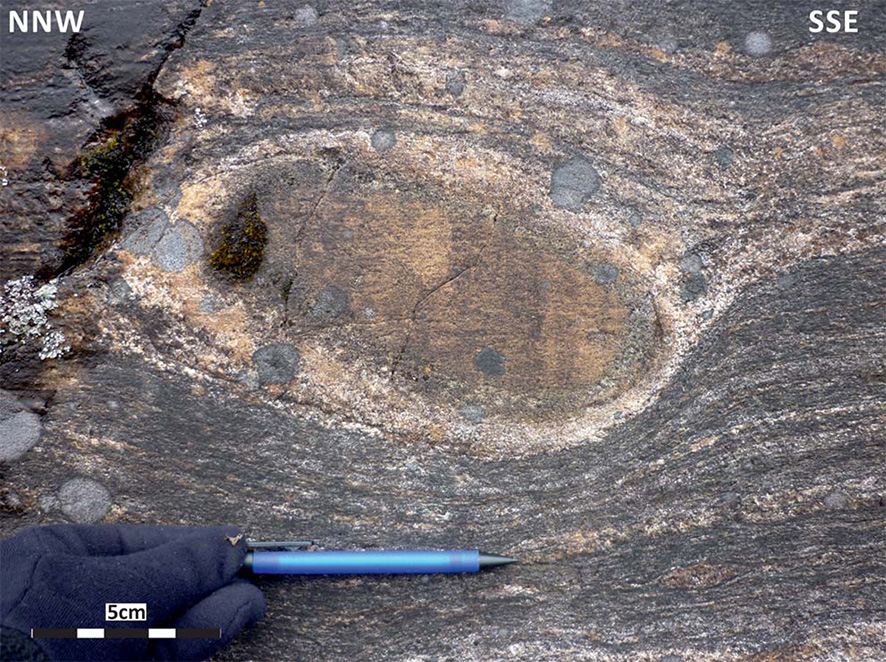4 The Greater Himalayan Sequence
The Greater Himalayan Sequence (GHS) is a ~5-20 km thick package of high-grade metamorphic rocks which span the length of the Himalaya (Le Fort, 1975; Pecher, 1989). The GHS package has experienced granulite- facies metamorphism, partial melting, migmatisation, anatexis, leucogranite formation and a prolonged history of high-temperature ductile deformation. It is thought that the GHS rocks were buried to depths of over 20-30 km in the crust before being extruded due to movement on the MCT and STDS (Grujic et al. 1996).
The GHS in the Sikkim Himalaya consists of a series of predominantly metapelitic rocks with subordinate quartzites, calc-silicates, orthogneisses, leucogranites and mafic rocks. The metapelites have experienced peak pressure and temperature conditions of ~800°C and 10 kbar (Ganguly et al. 2000), with partial melting occurring during the extended metamorphic history (Chakraborty et al. 2003; Harris et al., 2004, Rubatto et al., 2013). Monazite and zircon geochronology reveals that the GHS has a prolonged history of accessory phase growth during partial melting and amphibolite- granulite facies metamorphism during the Oligocene-Miocene (Rubatto et al. 2013). The geochronological (Catlos et al., 2004; Rubatto et al., 2013) and metamorphic data (Ganguly et al. 2000) indicate that the GHS in Sikkim consist of at least two units separated by a cryptic shear zone (Kellett et al., 2013; Figure 1.1). Potentially similar tectonic discontinuities have been identified within the GHS in Bhutan (Warren et al., 2011, Grujic et al., 2011) and Nepal (e.g., Groppo et al., 2009, Carosi et al., 2010; Montomoli et al., 2013; Larson et al., 2013) and are thought to have formed during exhumation of the GHS.
Finally, the occurrence of strongly retrogressed mafic granulites in the highest structural levels of the GHS (Rolfo et al., 2008; own observations) suggest that this segment of the GHS has been exhumed from the base of the south Tibetan crust similar to the situation in western Bhutan (Grujic et al., 2011) and eastern Nepal (Cottle et al., 2009; Groppo et al., 2007). The GHS is well exposed in road cuts and trekking routes through several locations throughout the Sikkim Himalaya; Yuksom in the west, Tsomgo lake road to Natu La in the east and the Lachen and Lachung valleys in the north. This section of the virtual fieldtrip continues from the MCT (section 3) at Chungthang up into the Lachung valley in the North of Sikkim (Figure 3 .1) where the GHS rocks can be seen.
4.1 Chungthang (N 27.60157˚, E 88.64568˚)
Chungthang, as described in section 3.7, marks the start of the GHS proper, where the upper amphibolite- to granulite- facies gneisses are cross cut by leucogranite veins. The transition from LHS to GHS through the zone of deformation associated with the MCT, as described in the previous section, does not mark a sharp break in either lithology or metamorphic grade. There is a gradual increase in peak metamorphic temperature from ~500°C to ~800°C with a relatively small variation in pressure conditions from ~8-10 kbar through the LHS to GHS transition (Dubey et al. 2005; Dasgupta et al. 2009; Mottram, 2014). The rocks of the GHS crop out in both the Lachen and Lachung valleys of North Sikkim. The Mw 6.9 Sikkim earthquake of September, 2011 caused some large landslides in this region (Rajendran et al., 2011; Mahajan et al., 2012; Fig. 4.1) exposing some very fresh, if rather unstable, exposure of the rocks in this area.
Figure 4.1. Landslides
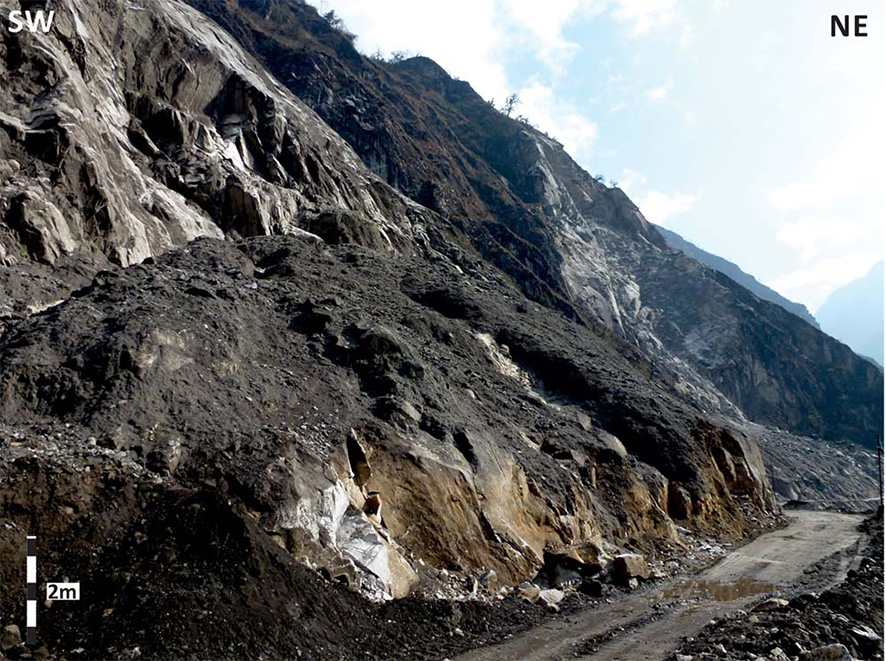
Large landslides disrupted the rocks in the North of Sikkim after the September 2011 earthquake. This photograph shows the fresh outcrops of gneiss exposed in the Lachung valley
4.2 Bhimnala falls (N 27.63433˚, E 88.70430˚)
The rocks exposed along the road between Chungthang and the Bhimnala Falls show some key features of the geology of the GHS in the Sikkim Himalaya. Mafic sills and boudins can be seen in the GHS throughout the Sikkim Himalaya (Faak et al., 2012) and beyond (Figs. 4.2, 4.3). The lack of geochronological constraints on when the mafic bodies were intruded makes it difficult to interpret their geological significance, however they could be related to the felsic orthogneiss bodies present in the GHS or represent bodies intruded early in the history of the Himalayan collision. Previously determined ages range from Neoproterozoic (Cottle et al., 2009) to Miocene (Grujic et al., 2011). Throughout the eastern Himalaya, similar mafic boudins locally preserve evidence for high-pressure metamorphism (e.g. Lombardo and Rolfo, 2000; Cottle et al., 2009, Groppo et al., 2007; Grujic et al., 2011), including an example in northern Sikkim (Rolfo et al., 2008).
Figure 4.2. Mafic sills and boudins
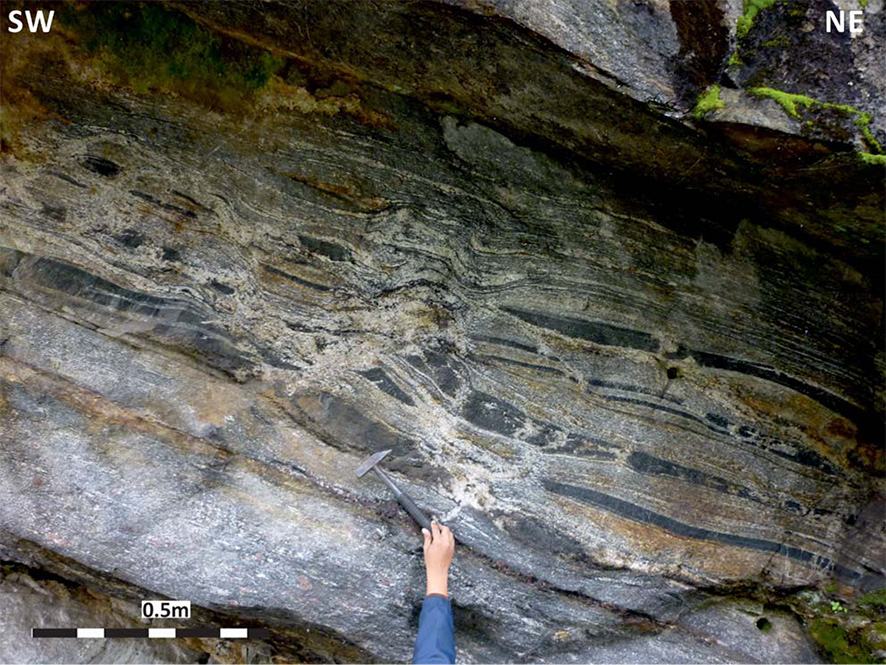
Discontinuous mafic sills and boudins intruded into the metapelitic gneiss of the lower Lachung valley
The rocks at Bhimnala falls are migmatitic metapelitic gneiss with an assemblage containing garnet+biotite+quartz+plagioclase+K-feldspar+sillimanite+spinel. The rocks are pervasively ductily deformed (Fig. 4.4), with the migmatitic banding folded into recumbent folds. These rocks have undergone peak metamorphic conditions of ~800°C and 9 kbar, where they equilibrated above the solidus. Evidence of spinel breakdown textures at the edge of garnets suggests that the rocks decompressed into the spinel (+cordierite) field on the retrograde path during isothermal decompression (Mottram, 2014). Monazite data from these rocks indicates that they had a prolonged history of accessory phase growth, starting in the late Oligocene and continuing until the mid-Miocene (Catlos et al., 2004; Rubatto et al. 2013; Mottram, 2014). The protracted history of monazite growth suggests the GHS rocks were at depth within the thickened crust for several tens of million years.
Figure 4.4. Folded migmatitic metapelite
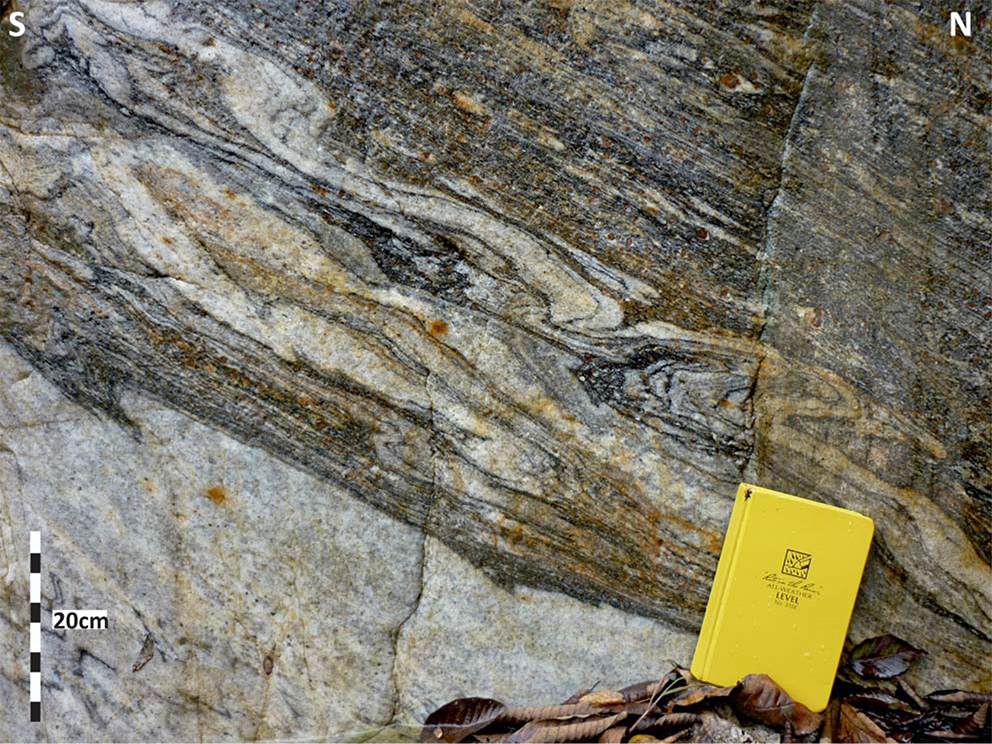
Ductily folded migmatitic metapelite outcropping at Bhimnala falls. Garnets with pressure shadows can be seen in the top right of the photograph
4.3 Lachung (N 27.68598˚, E 88.73853˚)
The rocks exposed between Bhimnala falls and the village of Lachung represent further exposures of pelitic gneiss, migmatite (Fig. 4.5), mafic bodies, calc-silicate (Fig. 4.6) and leucogranite. Leucogranite bodies are present throughout the GHS of the Himalaya and formed due to the melting of metapelitic GHS source rocks (Guillot and Lefort, 1995). Leucogranite at the top of the GHS package are described in section 5 and in Kellett et al. (2013).
Within the village of Lachung is an example of a GHS orthogneiss similar in appearance to the Lingtse gneiss which intrudes the LHS rocks in Sikkim (i.e. those at location 3.1 Tashi viewpoint). These orthogneisses represent pre-Himalayan granites which were intruded into the GHS protolith. The body at Lachung has been dated at ca. 520-490 Ma (Mottram et al., 2014) indicating it may have been intruded during a widespread Cambro-Ordovician orogeny (Gehrels et al. 2006).
Figure 4.5. Folded melt vein
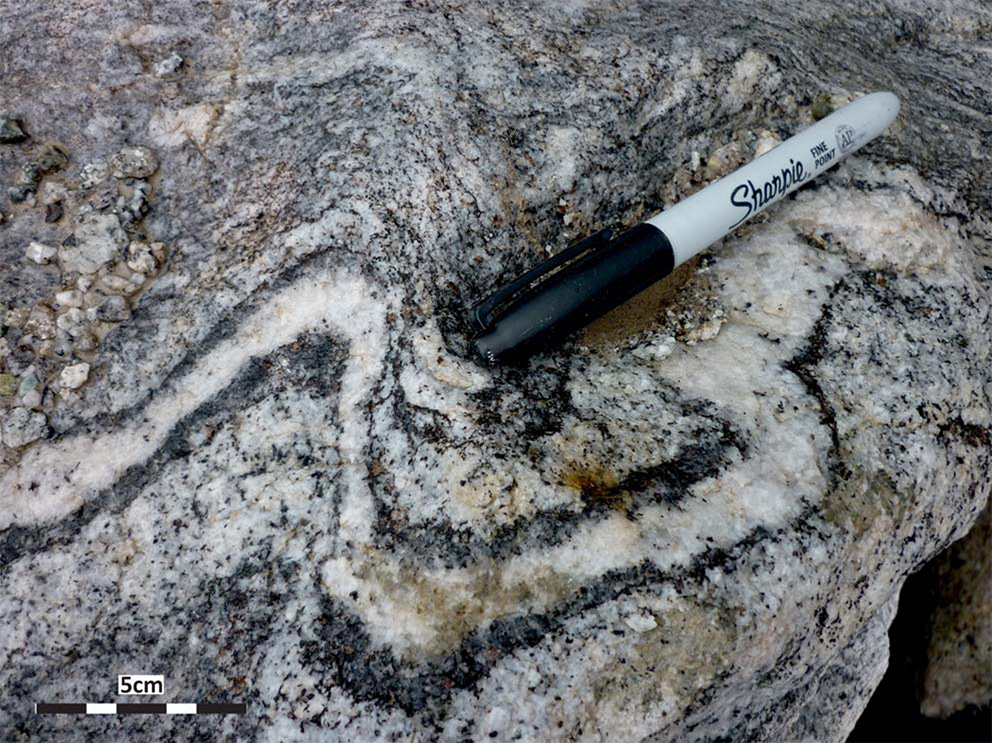
Folded melt vein with well-developed biotite selvage in a GHS migmatite within the Lachung valley
Figure 4.6. Folded calc-silicate
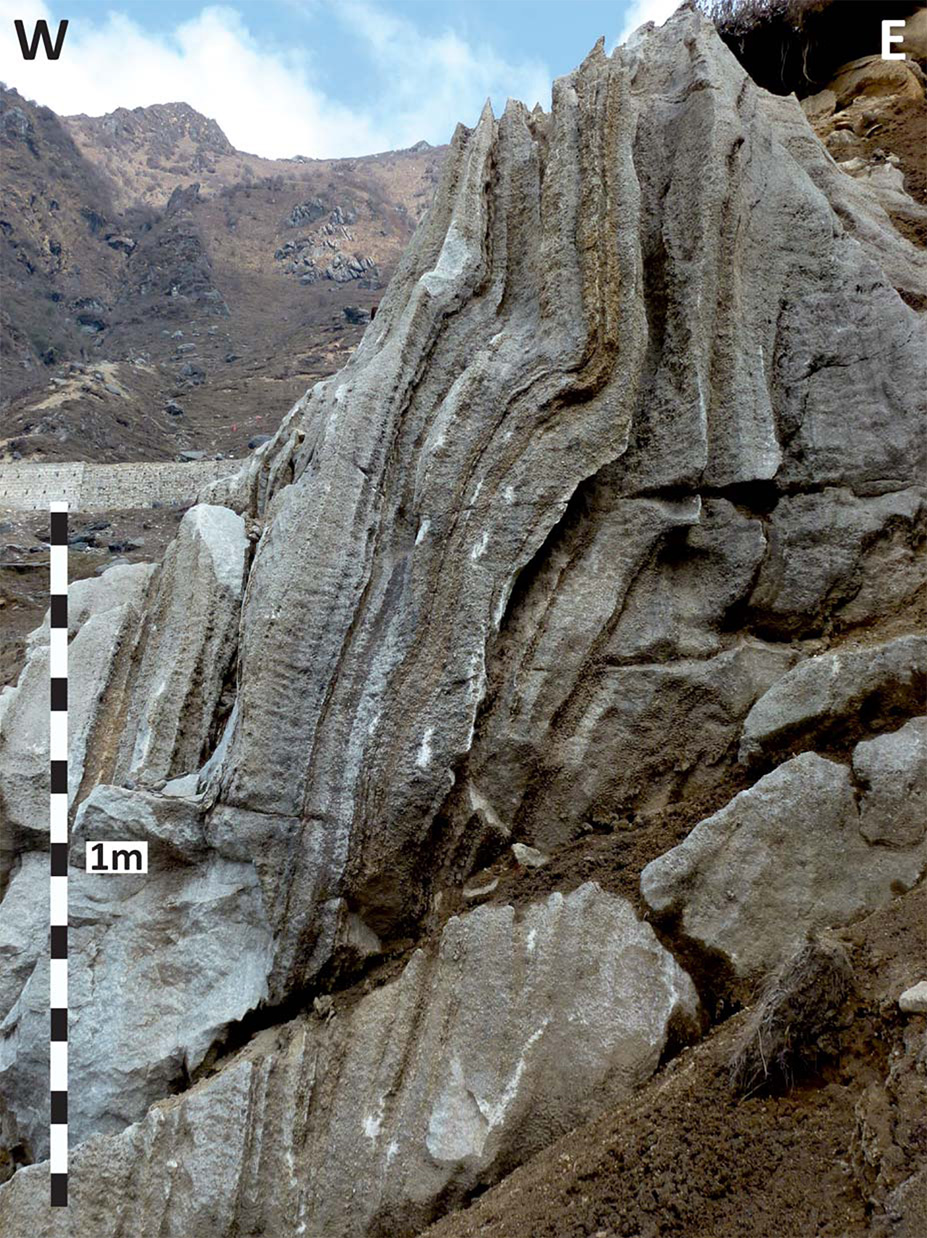
Folded calc-silicate with distinctive weathering pattern common in calc-silicate bodies
4.4 North to Yumesamdung (N 27.93057˚, E 88.73407˚)
The road continues north through GHS rocks from Lachung to Yumesamdung in the extreme north of the area (close to Gurudongmar Lake- section 5.5). The metapelitic gneiss exposed along the way continues to display the features outlined in the localities above, with prominent sillimanite-grade metamorphism (Fig. 4.7.). Due to an apparent tectonic discontinuity between the upper and lower structural levels of the GHS as revealed by distinctly younger monazite ages in the structurally higher samples (Rubatto et al., 2013), it has been suggested that there may be at least one discrete thrust preserved within in the pervasively deformed GHS of the Sikkim Himalaya. This structure may be similar in nature to cryptic thrusts found in Bhutan (Warren et al. 2011; Grujic et al. 2011), eastern Nepal (Larson et al., 2013) and western Nepal (Groppo et al., 2009; Carosi et al. 2010) that facilitated exhumation of the GHS at different stages of the collision.
Figure 4.7. Sillimanite lath in a GHS sillimanite gneiss
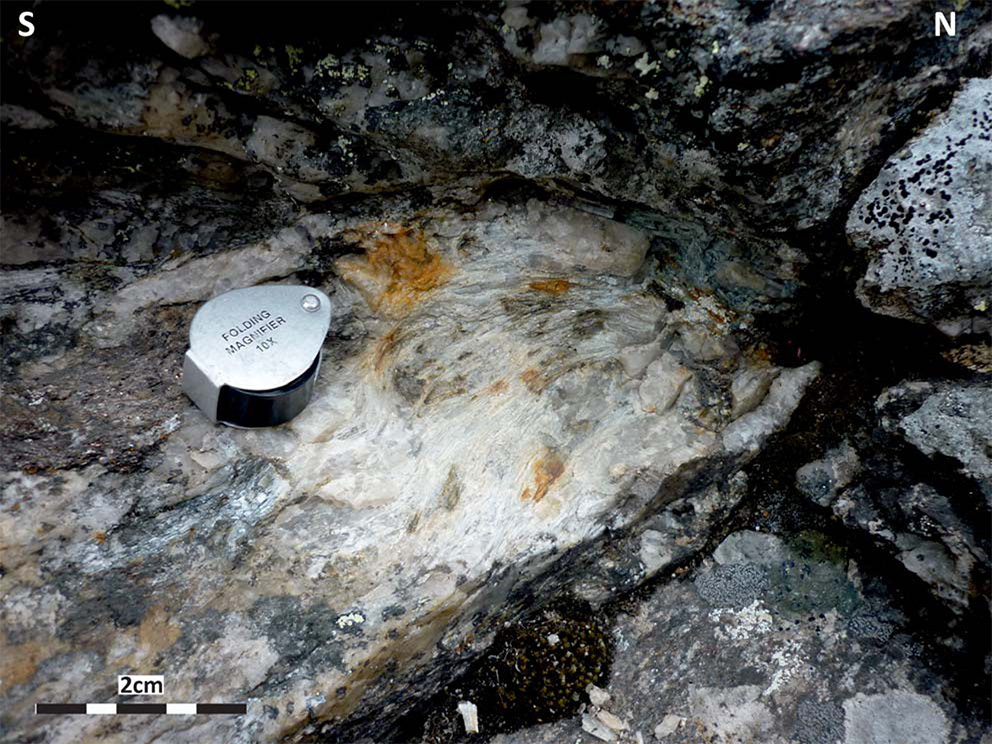
Prominent sillimanite lath in a GHS sillimanite gneiss from Yumesamdung in the upper Lachung valley
